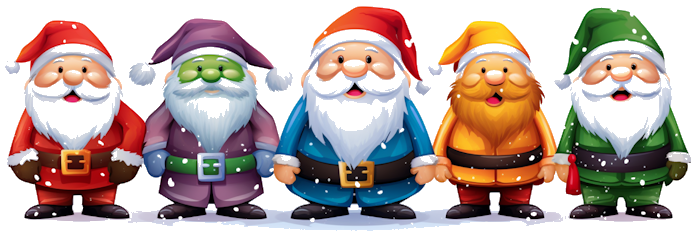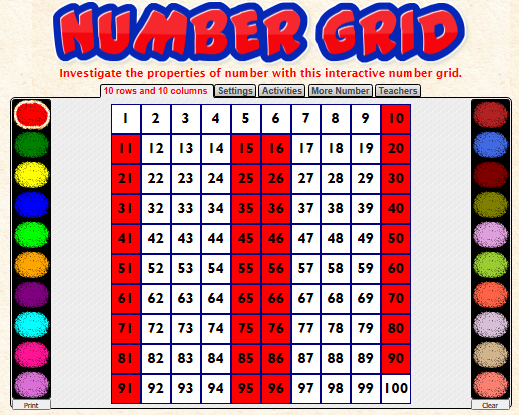Sign In | Starter Of The Day | Tablesmaster | Fun Maths | Maths Map | Topics | More

Seasonal Greetings! December has arrived and along with it comes the Transum Newsletter for December 2023. It begins with a festive puzzle of the month.
If the average (mean) cost of 20 Christmas presents is £50. The cost of each present is a different whole number of pounds. Find the cost of the most expensive gift assuming it was as expensive as it could possibly be.
If you haven't figured out the answer by the end of the year that answer will be in the January Newsletter. While you think about it here are some of the key resources added or updated during the last month and which feature in the ChristMaths collection.
The exercise formerly known as Christmas Presents has now been expanded and renamed as Festive Fivesome. The original problem solving exercise is still there as Level 1 but the real challenge for upper-Primary/lower-Secondary students is Level 3 starring five of Santa's helpers.

Also recently added to the ChristMaths collection is the Christmas Logic Puzzle. Complete the table showing the facts about three people who really enjoy Christmas. They each have different jobs, different skills and live in different places. If your pupils haven't used basic truth tables in problem solving before this may be a good place to start.
The Christmas Colouring activity has been updated for 2023 with a brand new picture. Additionally, I've introduced an extension activity that I believe offers an engaging and substantial learning experience. Students are encouraged to create their own Christmas colouring activity. This involves first drawing the outline of a Christmas scene and then assigning numbers to different regions based on a unique number rule they create for each colour. It's important that they ensure no regions are ambiguous (i.e., no region should adhere to more than one rule). I would be delighted to share any interesting images and rules your students come up with.
Did you know that, as a Transum subscriber, you possess almost magical, seasonal powers? The updated Maths Advent Calendar keeps its windows and doors firmly locked until their numbers match the date in December. However, if you're eager to peek ahead and discover upcoming surprises, simply log in to the website. Once logged in, a button will appear, enabling you to unlock the portals. This allows you to preview the activities, jokes, and anagrams planned for any specific day.
This month's comments about the current artificial intelligence boom are based on an email I received from Allan and his attempt to get a solution for the following problem from the textbook he uses: "Felix goes up an escalator. If he takes 1 step per second, he will reach the top after 20 steps. If he goes up 2 steps per second, he reaches the top after 32 steps. How many steps does the escalator have when stationary?". Here are three different answers.
ChatGPT version 3.5: 12 steps,
ChatGPT version 4: 41 steps,
Bing’s ChatGPT: 80 steps.
I agree with one of the answers above but I won't ruin your fun and I will let you work out the answer for yourself. Let me know if you come up with a good method.

Conventional histories of mathematics are dominated by well-known names like Pythagoras, Leibniz or Newton. But to concentrate solely on figures from Europe gives us only a patchwork understanding of the rich and varied history of mathematical achievement around the world. This is the subject of a More or Less podcast called The Overlooked Mathematicians of History. It's worth listening to.
Finally the answer to last month's puzzle which was: How many positive two-digit numbers are there whose square and cube both end in the same digit?
The answer is 36.
The square and cube of an integer end in the same digit if, and only if, the integer itself
ends in 0, 1, 5 or 6. The two-digit numbers with this property can have any tens digit
from 1 to 9 so there are 4 × 9 = 36 such two-digit numbers.
The first five correct answers were received from Mala Bhaduri, Allan Christie, Ann Roberts, Rick Blair and Iniha J Rajan. Their solutions can be seen below.
The source of the puzzle was the Senior Kangaroo Mathematical Challenge 2011 from the United Kingdom Mathematics Trust.
Finally a very happy Christmas to you and those close to you. Stay safe, healthy and happy and look forward to a mathematically exciting 2024. In the meantime spread the seasonal spirit with the activities from the updated ChristMaths collection.
John
PS. I'm buying all my friends abacuses for Christmas.
They're not expensive but that doesn't matter ...
... it's the little things that count!
Mala, Papatoetoe High School
Wednesday, November 1, 2023
"All positive two digit numbers ending with either 0 or 1 or 5 or 6 have their squares and cubes ending with 0/1/5/6. So there are 36 positive two-digit numbers in total that have this property."
Alan, Germany
Thursday, November 2, 2023
"My guess would be 36.
There are 4 possibilities in every ten and 9 possible tens (assuming we are regarding zero as not a digit)
E.g. 10, 100,1000
As well as two digit numbers ending 1, 5 and 6.
11, 121, 1331 / 15, 225, 3375 / 16, 356, 4096."
Ann,
Friday, November 3, 2023
"
(1) We only need to think about the units digit of the 2-digit number. This gives us 10 digits to consider.
(2) We can calculate d x d and d x d x d for each of these digits d.
0 x 0 = 0 and 0 x 0 x 0 = 0 yes
1 x 1 = 1 and 1 x 1 x 1 = 1 yes
2 x 2 = 4 and 2 x 2 x 2 = 8 no
3 x 3 = 9 and 3 x 3 x 3 = 27 no
4 x 4 = 16 and 4 x 4 x 4 = 64 no
5 x 5 = 25 and 5 x 5 x 5 = 125 yes
6 x 6 = 36 and 6 x 6 x 6 = 216 yes
7 x 7 = 49 and 7 x 7 x 7 = 343 no
8 x 8 = 64 and 8 x 8 x 8 = 512 no
9 x 9 = 81 and 9 x 9 x 9 = 729 no
Note: There is a more efficient method of calculating the units digit of any cubed number. We can simply take the units digit of the squared number (ignore the tens) and continue. If we start with 4, then 4 x 4 is 16. Ignore the ten, 6 x 4 = 24 so 4³ ends in a 4.
Only two digit numbers ending in 0, 1, 5 and 6 will have squares and cubes ending in the same digit.
There are four possible ending digits and each gives 9 solutions, giving us a total of 36 solutions.
You could also say that the two digit number itself, it’s square and it’s cube all end in the same digit.
Anyone interested in exploring further might like to investigate ‘cyclicity’. I can recommend this lovely video from Learners’ Planet:
How to Find the Unit Digit of Large Powers | Unit Digit Tricks | Learners' Planet
https://www.youtube.com/watch?v=ujifcj0iiEI
The whole video is excellent, but you might like this table for your newsletter problem:
https://youtu.be/ujifcj0iiEI?si=5MVUFhr7qOwwVZB2&t=497
Thank you for sharing your lovely problem."
Rick,
Saturday, November 4, 2023
"Initially, I solved the puzzle the old-fashioned way, using my brain. One has to only focus on the last digit, which quickly finds numbers ending in 0, 1, 5, and 6, since when squared, the last digit is the same as the original number, and hence, will be the same when cubed. Then, to make sure these were the only choices, I did the multiplications on the other six ending digits, finding none that satisfied the criteria. Therefore, there are four numbers in each decade (for example, 10, 11, 15, 16, 20, 21, 25, 26, and so on).
Finally, I wrote a Python script to verify. In Python, indexing an array with minus 1 gets the last array element.
for TwoDigit in range(10, 99, 1):
TwoDigitSquared = TwoDigit * TwoDigit
TwoDigitCubed = TwoDigitSquared * TwoDigit
if str(TwoDigitSquared)[-1] == str(TwoDigitCubed)[-1]:
print (TwoDigit, TwoDigitSquared, TwoDigitCubed) "
Iniha J Rajan, Hilversum, Netherlands
Sunday, November 5, 2023
"The answer to the puzzle of the month for November is 36.
I found the pattern by first squaring and cubing the first seven 2 digit numbers. The patters is that every multiple of five's square and cube number end in the same digit. Then the number after every multiple of five's cube and square also ends in the same digit. I wrote all the multiple of five's that are 2 digits, and the number after that, then counted them. The final number was 36."